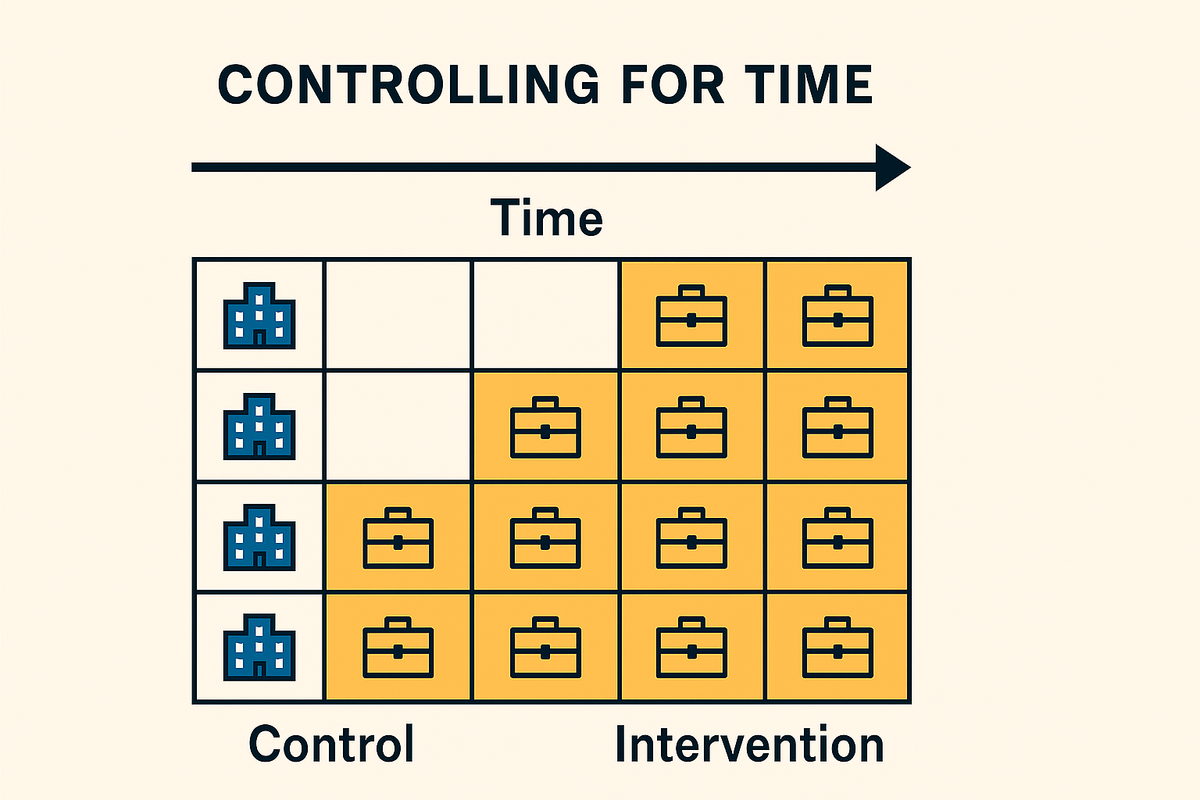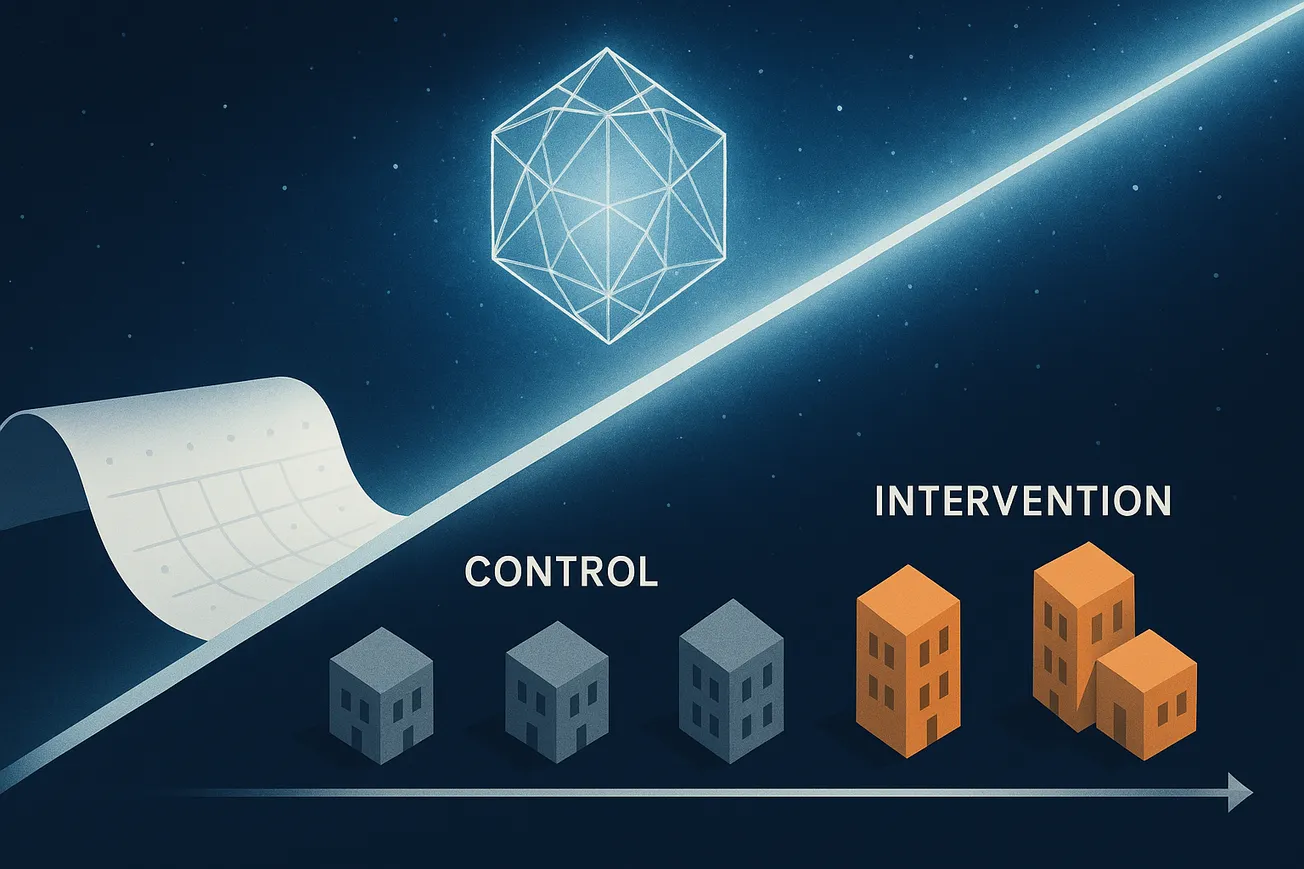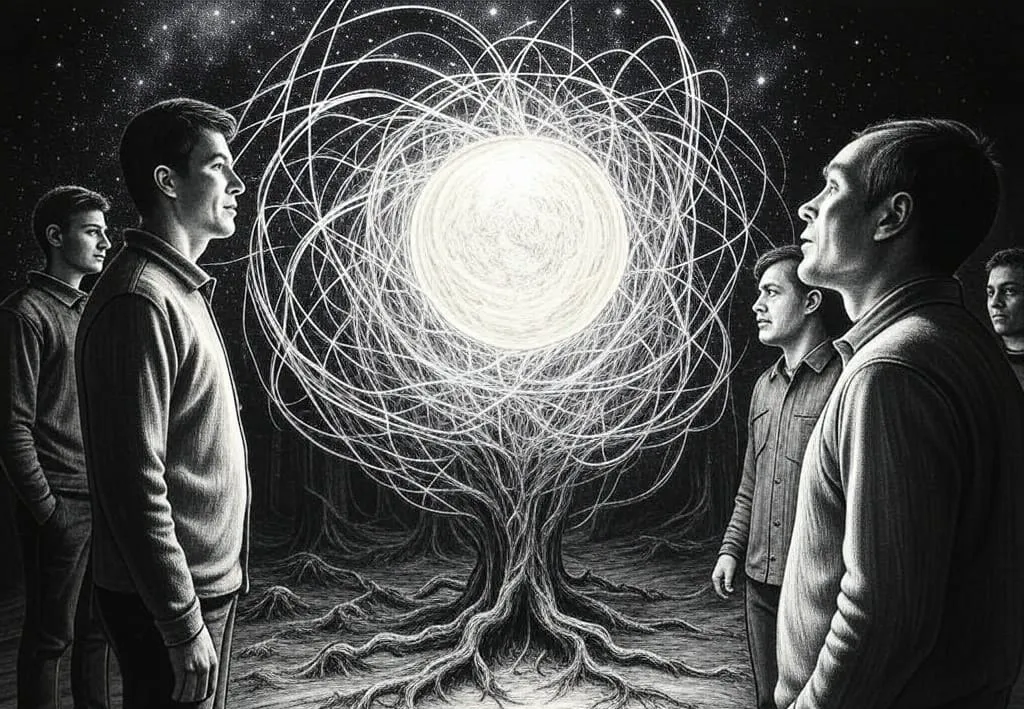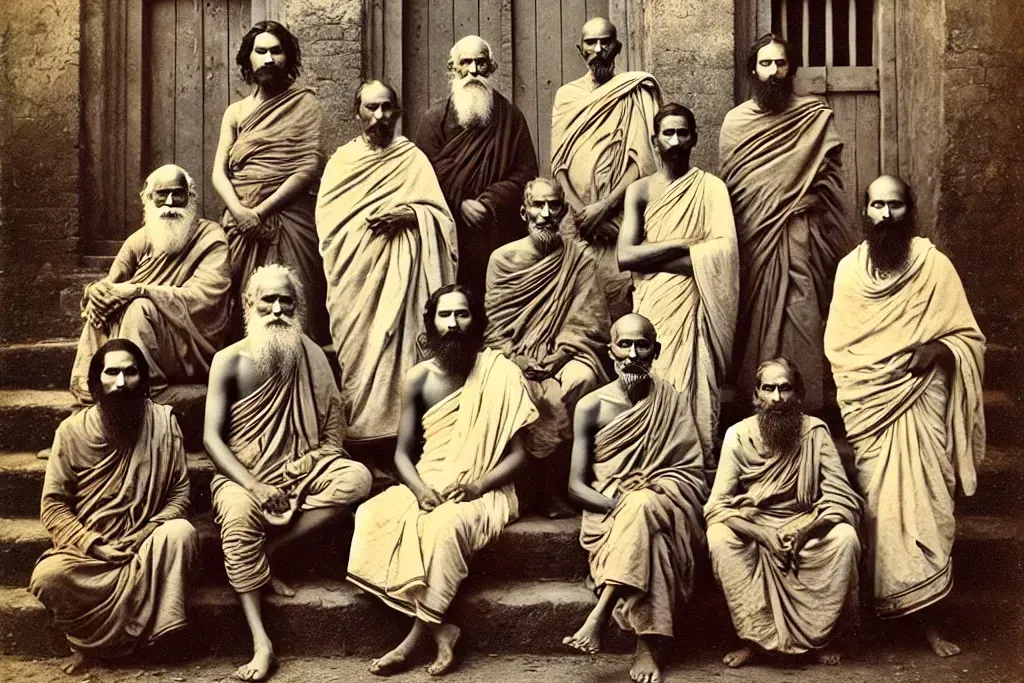Table of Contents
Introduction: The Flux of Time vs. Timeless Truths
Philosophers from Heraclitus onward have grappled with the tension between a world in constant flux and the hope for enduring truths. “Everything changes and nothing stands still,” the Greek sage noted over two millennia ago (Heraclitus - Wikiquote). Science, at its core, often strives to transcend this relentless flow – to extract insights that remain valid outside the whirling context of time. In modern research methodology, few designs illustrate this philosophical ambition better than the Stepped-Wedge Cluster Randomized Trial (SW-CRT). By systematically staggering an intervention’s rollout to different groups over time and controlling for time effects, the SW-CRT becomes more than just a trial design; it serves as a metaphor for science’s attempt to isolate causal truth from the confounding currents of temporal change.
In this post, we’ll explore the deeper epistemological and metaphysical implications of “controlling for time” through the lens of the SW-CRT. We will see how, by adjusting for secular trends and timing, researchers aim to strip away the confounding influence of time to reveal a “pure” effect of an intervention – almost as if glimpsing a causal truth that stands outside time’s flow. We will then expand this perspective into other domains: examining how economists tackle temporal confounders in policy evaluation, how biologists struggle with time’s complexity in gene regulation and evolution, and even how consciousness and life itself pose challenges to any timeless notion of causation. The journey will blend methodological clarity with philosophical reflection, suitable for an audience of philosophers of science, theoretical scientists, and methodologists intrigued by the intersection of experimental design and the nature of reality.
The Stepped-Wedge Trial: Staggering Time to Isolate Cause
At first glance, a Stepped-Wedge Cluster Randomized Trial is a practical solution to an ethical and logistical problem. Instead of withholding a potentially beneficial intervention from a control group indefinitely (as in a parallel trial), the SW-CRT eventually delivers the intervention to all groups, but on a staggered schedule. Imagine several hospitals (clusters) initially providing standard care (control). At regular time intervals (say, every few months), one cluster at a time switches from control to the new intervention, until all are eventually under the intervention condition. Throughout the trial, outcomes are measured in each cluster. By the end, every cluster has experienced both the control and intervention at different points in time, in a sequence determined at random.
Illustration: A schematic of a Stepped-Wedge trial. Each row represents a cluster (e.g. a hospital) and each column a time period. Blue squares indicate periods where a cluster is under control, and orange squares indicate periods after the cluster has crossed over to the intervention. The staggered diagonal pattern of orange blocks shows the sequential rollout of the intervention to all clusters over time. Crucially, the design allows comparison of outcomes between control and intervention conditions while accounting for overall temporal trends.
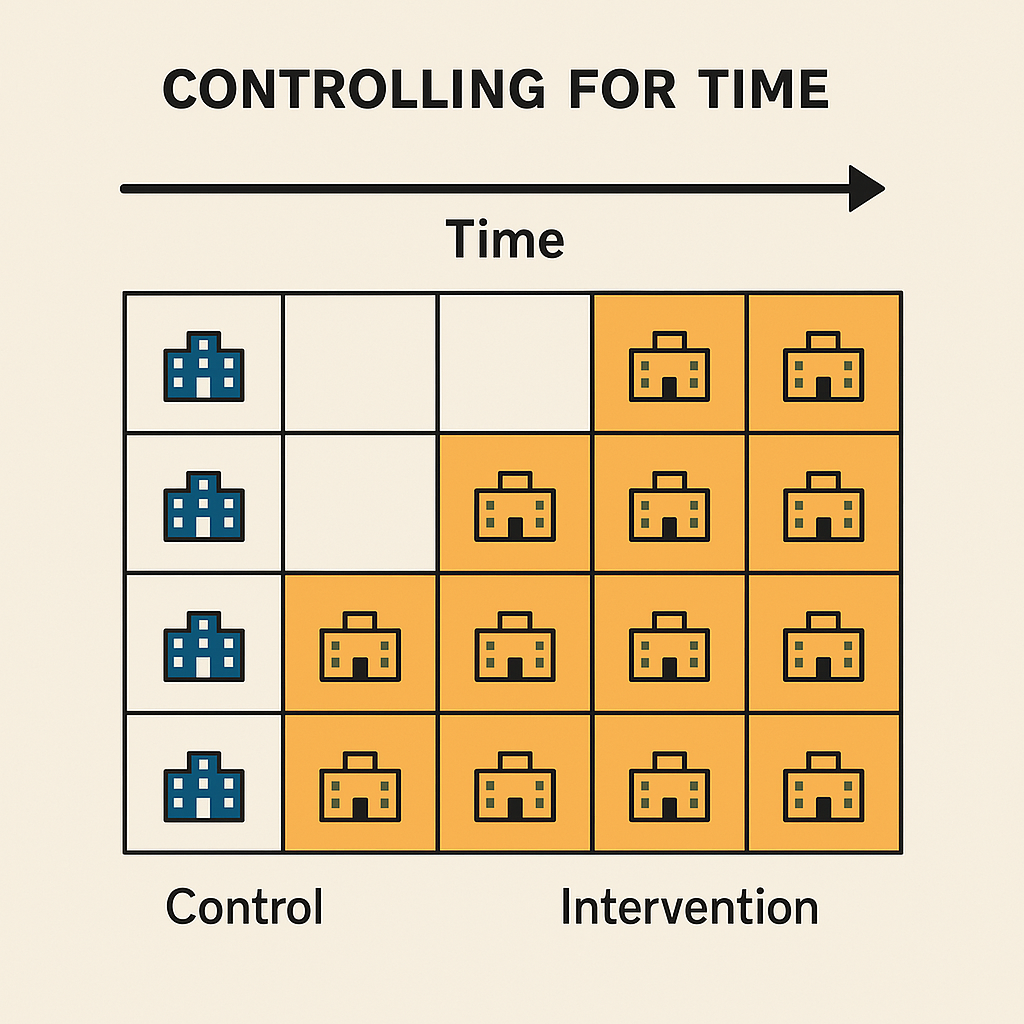
From a methodological standpoint, the SW-CRT’s power lies in how it “controls for time.” Because the rollout is staggered, at any given time point there are some clusters still in control and others already in intervention. This overlap means the effect of the intervention can be extracted by comparing groups that are contemporaneous, rather than relying solely on before-vs-after comparisons that might be biased by broader trends. In statistical analysis, one includes time as a factor – adjusting for the secular trend (the underlying change in outcomes over time that would have occurred regardless of the intervention). By doing so, the design accounts for any general improvements or deteriorations that occur during the study (for example, due to seasonality or background policy changes), preventing these from masquerading as an intervention effect.
In fact, without proper adjustment, the very strength of the stepped-wedge – its progression through time – would confound the results. As one methodological review notes, “the staggered treatment initiation induces confounding by time and unbiased estimation of intervention effect requires statistical adjustment for [the] secular trend” ( Stepped Wedge Cluster Randomized Trials: A Methodological Overview - PMC ). By correcting for the influence of time, the SW-CRT aims to reveal what the intervention’s impact truly is, as if the intervention had been introduced in a timeless vacuum. Epistemologically, this is an effort to know the effect in itself: to isolate the causal signal by filtering out the noise of temporal change. Metaphysically, it flirts with the idea that a cause (here, the intervention) has an intrinsic efficacy independent of when it occurs – an almost Platonic quality of the intervention that researchers seek to measure.
Stripping Away Time to Reveal Causal Truth
The image of “controlling for time” invites a powerful metaphor: peeling away the layers of temporal context to expose a core truth. In a stepped-wedge trial, each step of the wedge is like a page of the calendar being turned, with the trial design holding those pages to the light to see what constant image might shine through from behind them. By the final step, when all clusters have received the intervention, the hope is that the accumulated data have canceled out the mere effects of time’s passage, leaving behind the imprint of the intervention itself – a sort of causal essence.
The notion of a “truth outside of time” might sound mystical, but in scientific terms it relates to the idea of invariance. We seek results that hold irrespective of when and where they are tested – an invariant relationship between cause and effect. The stepped-wedge trial is a concrete attempt to achieve invariance by design. By accounting for time, it posits that an intervention’s effect can be made visible in its purity. In philosophical terms, we could say the SW-CRT is trying to glimpse a bit of the noumenal (the thing-in-itself, the intervention’s true effect) by cleverly arranging the phenomena (the observable outcomes over time).
This endeavor resonates with long-standing themes in the philosophy of science. Science often proceeds by isolating variables, holding everything else equal (ceteris paribus) to observe what one factor alone does. Time, however, is the one variable we cannot hold still – it marches on relentlessly, changing background conditions as it goes. The stepped-wedge design is ingenious because it doesn’t freeze time (an impossibility), but rather uses time’s structured progression as a tool, with randomization, to factor time out. We might liken it to a controlled cosmic experiment: since we cannot stop the river of time, we build a clever series of dams and channels (the staggered rollouts and adjustments) to measure the flow’s effect on our object of interest, subtracting the current’s pull to see the object’s own movement.
There is a metaphysical implication lurking here about the nature of causation: is the effect of an intervention something that exists in abstraction from time? The SW-CRT embodies the assumption that we can talk meaningfully about “the effect” of an intervention as an entity that can be the same yesterday, today, or tomorrow (were conditions identical). By removing temporal confounders, we chase an ahistorical cause – a cause purified of context. Of course, in reality, no cause is completely context-free; even in a stepped-wedge trial, the effect might change over time (e.g. an intervention could have a learning curve or diminish in effect). But the methodology explicitly tests for a time-invariant effect, and if such invariance is found, it’s as if we’ve discovered a small eternal truth amid the temporal world.
Economics: Policy Effects Amid Temporal Currents
Outside of clinical trials, consider the world of economics and policy evaluation. Here, too, temporal confounding is a formidable challenge. Policies are often implemented over time, and their impacts must be discerned against a backdrop of other changing conditions. A new educational program might launch in 2019 and seem to improve test scores by 2021 – but if national educational standards were rising anyway, or an economic boom improved family conditions, how do we know the gains weren’t simply part of a broader trend? As researchers at Evidence for Action succinctly put it, the crucial question is “how to account for other things that are changing at the same time (one type of confounding) … if we want to know whether a specific policy or practice change causes changes in outcomes, or if those changes are the result of something else going on.” (A Brief Discussion on Time-Varying Confounding in the Evaluation of Programs, Practices, or Policies | Evidence for Action) In other words, we need to untangle the effect of the policy from the ever-shifting tapestry of time.
Economists have developed their own repertoire of quasi-experimental designs to see beyond time in this sense. One widely used approach is the Difference-in-Differences (DiD) design. In a DiD analysis, one compares the changes in outcomes over time between a group that experienced a policy change (the “treatment” group) and a group that did not (the “control” group). By looking at differences of differences, the method effectively subtracts out any change that would have happened due to general time trends, under the assumption that in the absence of the policy the two groups would have moved in parallel. The strength of this approach is that any common temporal drift – economic growth, cultural shifts, seasonal effects – is canceled out, leaving behind the difference attributable to the policy itself. In practice, this requires the parallel trends assumption (that aside from the policy, the two groups follow the same trajectory over time) and careful checks to ensure no other time-varying confounders are at play. When those conditions hold, the analysis can claim an invariant causal estimate: “this policy improved outcomes by X,” ostensibly true regardless of the year, because we’ve netted out the year’s influence.
Another analogous design to the stepped-wedge in policy contexts is staggered adoption. Different regions or organizations implement a new policy or program at different times, sometimes for arbitrary or exogenous reasons. Researchers can exploit this staggered timing (much like the SW-CRT does deliberately) to compare units that have adopted the policy with those that will adopt it later, at overlapping points in time. This is conceptually similar to a stepped-wedge: all units eventually get the intervention (policy), but the staggered timing allows the analyst to use those not yet treated as controls for those already treated, while controlling for time. Modern econometric techniques have been developed to properly analyze such eventually-treated comparative scenarios, ensuring that secular trends and dynamic effects are accounted for. The goal, as always, is to isolate the true policy effect – as if we could hold the world still except for the policy change.
Philosophically, what economists seek is not so different from what the stepped-wedge trial seeks: an invariant relationship that we can trust for prediction and understanding. A minimum wage hike either increases employment, decreases it, or leaves it unchanged – but any real-world measurement of that effect is clouded by the particular year’s economic conditions, consumer preferences, and countless other temporal specifics. The art of causal inference in economics is to design studies that subtract the influence of time, revealing what the policy’s effect really is. In doing so, economists (perhaps unwittingly) echo the epistemological quest to find stable causal truths beneath historical contingencies. Just as a physicist might say a law is true outside of time (e.g. the law of gravity holds today as it did a thousand years ago), a well-identified policy effect aspires to a kind of timelessness: “if this policy were implemented at any other time (and all else equal), it would have the same effect.”
Biology: Life’s Temporal Complexity and Causal Entanglements
Biologists face a world of staggering temporal complexity. Living systems operate on a multitude of time scales – from the milliseconds of neuronal firing or enzymatic reactions, to the hours of cell cycles and circadian rhythms, to the years of an organism’s lifespan, and the eons of evolutionary change. In such systems, cause and effect are deeply enmeshed with time. A cause at one time can become a condition for a later effect, and the state of a system is often a layered record of its history. The challenge of isolating a cause in biology is thus often a challenge of untangling it from its temporal context.
Consider gene regulation in a developing embryo. Gene A might activate gene B, but only during a specific developmental window; at a later stage, the same activation might do nothing or trigger a completely different outcome. To understand the causal role of gene A, scientists perform carefully timed interventions – for instance, using genetic switches that can turn A on or off at precise moments, or observing knockouts across developmental stages. This is, in spirit, “controlling for time”: the experimenter holds timing as a variable to probe, attempting to freeze one moment and see what gene A does in that slice, separate from what might happen if A were active earlier or later. The temporal sequencing of such experiments is crucial. If one were to simply compare the final outcome of organisms with gene A on vs. off without regard to timing, one might miss that when the gene was active is the determining factor. Thus, biological causation often cannot be divorced from the timeline – the cause is not just gene A, but gene A at time T in context C. This complicates the quest for a “truth outside of time,” as the truth may very well be time-dependent.
Zooming out to evolution and ecology adds another layer of temporal entanglement. Evolutionary biologists have long debated the role of contingency – the idea that the outcomes of evolution hinge on the particular sequence of historical events. Stephen Jay Gould famously argued that if we could “rewind the tape of life” and play it again, the outcome might be completely different (Contingency (evolutionary biology) - Wikipedia). Small accidents of history (a mutation appearing at one time rather than another, a meteor striking at a particular moment) could send evolution down a different path. In this view, causal explanations in evolution are inherently historical. We can say a trait evolved “because” of selection pressure X, but that explanation lives within the narrative of that time; replay it under slightly altered timing and the cause-effect linkage might not hold. Evolution, being a historical process, resists the extraction of a neatly time-independent causal law. (There are counterarguments, of course: cases of convergent evolution suggest that in some contexts, similar outcomes do emerge repeatedly, hinting at more generalizable causal principles. But even convergence often operates within constraints and biases shaped by history (Contingency (evolutionary biology) - Wikipedia).)
The metaphysical question here is whether biological causation can be thought of as something that transcends time, or if it is fundamentally knitted into time’s fabric. When biologists identify a causal pathway – say, “gene X causes disease Y” – they usually mean under certain conditions and timeframes. Uncontrolled temporal factors (aging, diurnal cycles, etc.) could modulate or confound that relationship. Experimental designs like longitudinal studies or time-series interventions help control for some of this, analogous to how the SW-CRT controls for secular trends, but the intrinsic variability of living systems over time often means we find patterns rather than iron laws. The patterns may be robust (e.g. the genetic code is the same in organisms today as it was millions of years ago – a timeless truth of biology), yet many biological “truths” are context-dependent and thus time-dependent (e.g. the effect of a gene can differ across evolutionary time or developmental time).
In practical terms, biologists mitigate temporal confounding by using control groups and synchronized conditions. For example, in lab experiments on circadian rhythms, researchers will control the time of day at which samples are taken from all groups, to ensure that any difference observed is due to the experimental manipulation and not simply the natural oscillation of biological clocks. Similarly, when observing ecosystems, ecologists might use paired plots observed over the same seasons to factor out seasonal changes. These are all attempts to hold time constant or account for it. Yet, the dream of identifying a truly timeless biological cause often runs up against life’s penchant for change. Life is, by definition, a process in time; understanding life requires embracing that four-dimensional quality rather than stripping it away entirely. The SW-CRT, used increasingly in fields like public health or implementation science, is one tool by which biologists and epidemiologists try to impose a structure on time to glean clear answers (for instance, testing a new health program by rolling it out to different clinics in phases). The success of such approaches reaffirms that while biological systems are complex, carefully designed studies can still pinpoint causation by neutralizing the confounding effects of time – giving us insights that feel like glimpsing a stable fact in the midst of chaos.
Consciousness and Life: The Challenge of Timeless Explanation
If unraveling causality is challenging in biology, it verges on the profound when we turn to consciousness and the phenomenon of life itself. Conscious experience is inherently dynamic: our thoughts, perceptions, and feelings unfold in time and are remembered across time. The brain does not simply produce a static output in response to an input; it integrates information over milliseconds to seconds (the so-called “specious present” of consciousness), and it is shaped over years and decades by development and learning. How can we even conceive of a “timeless” explanation for a conscious process? Any given mental state is a snapshot in a continuous stream. To explain it causally, we invariably reference the prior brain states or stimuli that led to it (“she felt fear because a moment earlier she saw a looming shape, triggering a cascade of neural signals…”). The cause and the experience are bound in a tight temporal sequence.
Yet, the scientific impulse is to find general principles of consciousness – maybe even brain processes that would operate the same regardless of the particular moment. For instance, neuroscientists seek neural correlates of consciousness that are consistent (a certain pattern of gamma-wave synchronization might be required for conscious awareness, for example). In doing so, they are searching for something invariant: a causal condition for consciousness that is not tied to a unique moment but is universally true whenever that condition is met. This is analogous to controlling for time, in that one wants a relationship that isn’t simply an artifact of a particular sequence of events. However, conducting experiments on consciousness often involves playing with time itself – using techniques like masking (where a first image is shown and then quickly covered by a second, to see if the first enters awareness) or temporal illusions, researchers manipulate the timing of stimuli to infer how the brain pieces together cause and effect. The famous Libet experiment, which suggested that brain activity predicting a decision precedes the conscious awareness of deciding, raises deep questions about the timing of cause and effect in volition. It appears as if the “cause” (brain readiness potential) happens before what we subjectively think of as the cause (the will to act) – challenging our intuitive, time-ordered narrative of decision-making. To make sense of such results, philosophers of mind and scientists must carefully define what counts as the cause and what is the effect, sometimes reconsidering how time order relates to agency.
Life as a whole – in the broad sense of living systems – also poses the question of whether there are timeless truths in biology or whether everything is fundamentally time-bound. We might say “water is essential for life” as a timeless biological truth, but the manifestation of that truth is that without water over a certain time frame, an organism dies. The causal relationship between water and life is only meaningful in a temporal context (amount of time without water). Similarly, consider metabolism: it is a continuous process. To say a cell’s respiration “causes” energy production is to describe a steady-state throughput, not a one-off event. We measure rates (oxygen consumption per minute), inherently linking cause and effect to time. If we freeze time, metabolism stops and causation as we know it in that system vanishes. This underscores a philosophical point: some truths are essentially temporal – they are about patterns or rates over time rather than static relationships.
Consciousness might be one of those phenomena that defy a fully atemporal description. The richness of a lived moment comes partly from its relationship to the past and future (memory and anticipation). Any scientific theory of consciousness has to account for this integration over time (for example, how the brain maintains a unified experience over several seconds, or how personality is shaped by years of life). So while a stepped-wedge trial can neatly parcel out time to isolate an effect in a public health intervention, one could ask: what would it mean to “step-wedge” something as fluid as a stream of consciousness or a lifespan? It borders on absurd – we cannot randomly assign different segments of a single person’s life to different conditions in any meaningful way, nor re-run someone’s life with a different childhood as a control. Instead, when dealing with consciousness and whole lives, scientists and philosophers often rely on comparative method (comparing different individuals, say) and retrospective inference. But the lack of experimental control over time in these domains makes the inference of timeless truths even harder. We end up with rich narratives and correlations, but causal inference remains more tentative.
And yet, the human intellect doesn’t easily relinquish the search for invariants. In cognitive science and philosophy of mind, there is ongoing work to identify neural architectures or computational principles that might hold generally. The hope is that certain causal mechanisms in the brain (perhaps a certain feedback circuit or information integration threshold) are the key to consciousness, such that whenever and wherever those conditions are instantiated, conscious experience follows. That would be a kind of timeless causal truth: a blueprint of mind that could be abstracted from the living timeline. Whether this is actually achievable or is a mirage remains to be seen. It may be that any such blueprint inevitably abstracts away so much richness that it resembles the proverbial map that is not the territory – useful, but missing the essence of the journey through time that consciousness truly is.
Conclusion: Science as the Hunt for Invariant Truths Beneath Change
Across these explorations – from stepped-wedge trials to economic policies, from gene networks to consciousness – a common theme emerges: the pursuit of invariant truths beneath the changing surface of the world. This is arguably one of the grand projects of science. Every experiment that controls variables, every model that adjusts for confounders, every theory that generalizes from specific instances is motivated by the belief that there is some stability, some lawfulness, that can be found beyond the flux of appearances. Controlling for time is a particularly striking example because time is the dimension that guarantees change. If we can see through time’s confounding influence, we get a taste of eternity – not in a mystical sense, but in the sense of knowledge that doesn’t expire when the clock ticks forward.
The Stepped-Wedge Cluster Randomized Trial is a modern testament to this ambition. It is a highly practical tool born of necessity (ethical rollout of interventions, logistical constraints, etc.), yet it embodies a profound idea: by cleverly structuring who gets an intervention when, and by adjusting our analysis accordingly, we can pull back the veil of time and observe a causal relationship more clearly. It allows researchers to say, “Yes, the world was changing while we did this study, but we have accounted for that change. What we report now is what would hold true even if you took this intervention into another time and place, as long as the underlying secular trends are similar.” In short, it aims to report something timeless.
Of course, no scientific result is truly eternal or context-free. All knowledge resides in a context, and part of wisdom is knowing the scope and limits of an invariant claim. The SW-CRT might tell us the effect of a new clinic protocol averaged over a certain duration and context; an economist’s analysis might hold only under certain market conditions; a biologist’s pathway might function only in a particular species; a neuroscientist’s theory of consciousness might have caveats. But the guiding light is the same – the idea that beneath the myriad factors and ticking clocks, there is an understandable causal structure that, once found, can be reapplied and trusted.
In reflecting on this, we might return to the philosophical dichotomy with which we began: the world of becoming versus the world of being. Science does not deny the world of becoming – indeed, it measures and cherishes it – but it seeks in that very flow patterns of being that persist. Each time we “control for time,” we acknowledge the Heraclitean flux (time’s confounding effects) yet affirm a bit of Parmenedian stability (the invariant effect uncovered). The stepped-wedge trial is a beautifully literal dance with time in this regard, orchestrating the timing of events to let an underlying harmony emerge from the temporal cacophony.
Ultimately, the human project of science can be seen as an effort to transcend our ephemeral perspective and uncover truths that hold broadly – if not absolutely forever, at least across a wide swath of the conditions we care about. It is our way of stepping outside our moment to see what would happen if… to generalize our experiences into knowledge. In doing so, we inch closer to understanding the world not just as it appears in one fleeting instant, but in terms of principles that outlast the moment. Controlling for time in an experiment is a small act of rebellion against time’s tyranny over our inferences. It says: we know things change, but by careful design, we can still learn something that abides.
And when we do find such knowledge, however modest – a drug that truly saves lives regardless of when it’s given, a policy that reliably improves welfare in different eras, a biochemical law that holds across species, or a cognitive process that defines conscious awareness – we have achieved something deeply meaningful. We have carved out a piece of insight that stands firm in the stream of time, a stepping stone across the river of change. Science, in this sense, is the art of finding those stepping stones, of building a bridge of understanding grounded in timeless (or at least time-resistant) truths so that we may cross the waters of time with confidence. Each sturdy step – like the design of a stepped-wedge trial and the causal knowledge it yields – is part of that bridge, carrying us toward a fuller comprehension of a lawful universe in the midst of endless change.
Sources:
- Hemming K. & Taljaard M. Reflection on modern methods: when is a stepped-wedge cluster randomized trial a good study design choice? Int. J. Epidemiology. 49(3):1043-1052, 2020. (Discusses considerations and limitations of SW-CRT design).
- Li F. et al. Design and Analysis of Stepped Wedge Cluster Randomized Trials in the Presence of Time-Varying Treatment Effects. Statistics in Medicine. 40(3): 759-776, 2021. (On the importance of adjusting for secular trends and time-varying effects in SW-CRTs) ( Stepped Wedge Cluster Randomized Trials: A Methodological Overview - PMC ).
- Evidence for Action (E4A) Blog. A Brief Discussion on Time-Varying Confounding in the Evaluation of Programs, Practices, or Policies. 2021. (Explains the challenge of other changes happening over time in policy evaluation) (A Brief Discussion on Time-Varying Confounding in the Evaluation of Programs, Practices, or Policies | Evidence for Action).
- Wikipedia – Contingency (evolutionary biology). (Summary of Stephen J. Gould’s “tape of life” concept and the role of historical contingency in evolution) (Contingency (evolutionary biology) - Wikipedia) (Contingency (evolutionary biology) - Wikipedia).
- Heraclitus, as quoted by Plato in Cratylus 402a. (Fragment on the ever-changing nature of reality: “Everything flows and nothing abides.”) (Heraclitus - Wikiquote).
In-depth analysis - Stepped-Wedge Cluster Randomized Trials: Methodological Foundations and Case Study
